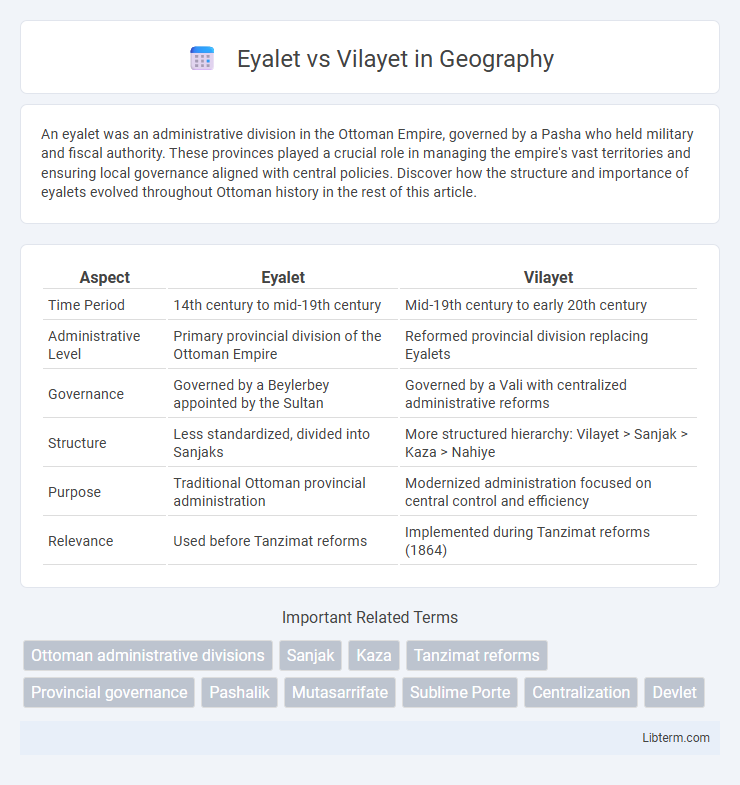An eyalet was an administrative division in the Ottoman Empire, governed by a Pasha who held military and fiscal authority. These provinces played a crucial role in managing the empire's vast territories and ensuring local governance aligned with central policies. Discover how the structure and importance of eyalets evolved throughout Ottoman history in the rest of this article.
Table of Comparison
| Aspect | Eyalet | Vilayet |
|---|---|---|
| Time Period | 14th century to mid-19th century | Mid-19th century to early 20th century |
| Administrative Level | Primary provincial division of the Ottoman Empire | Reformed provincial division replacing Eyalets |
| Governance | Governed by a Beylerbey appointed by the Sultan | Governed by a Vali with centralized administrative reforms |
| Structure | Less standardized, divided into Sanjaks | More structured hierarchy: Vilayet > Sanjak > Kaza > Nahiye |
| Purpose | Traditional Ottoman provincial administration | Modernized administration focused on central control and efficiency |
| Relevance | Used before Tanzimat reforms | Implemented during Tanzimat reforms (1864) |
Introduction to Ottoman Administrative Divisions
The Ottoman Empire's administrative divisions evolved from Eyalets to Vilayets to enhance governance efficiency and centralization. Eyalets, large provinces governed by Beylerbeys, were replaced in the mid-19th century by Vilayets, which introduced a more structured hierarchy with appointed governors, councils, and defined administrative responsibilities. This transition aimed to modernize provincial management, improve tax collection, and reinforce state control during the Tanzimat reform period.
Defining Eyalet: Origins and Structure
Eyalet was an administrative division in the Ottoman Empire established in the 14th century, serving as a primary territorial unit governed by a Beylerbey appointed by the Sultan. Originating from the medieval Islamic caliphates' provincial system, the Eyalet combined military and civil authority within its borders, structured into sanjaks or districts managed by sanjakbeys. This governance framework allowed centralized control while facilitating tax collection, law enforcement, and local administration under the Ottoman hierarchy.
Understanding Vilayet: Reform and Modernization
The Vilayet system, introduced by the Ottoman Empire in 1864, marked a significant reform aimed at modernizing provincial administration, replacing the older Eyalet structure. The Vilayet Law established a hierarchical and more centralized government with elected councils and appointed governors, enhancing bureaucratic efficiency and local governance. This reform facilitated better tax collection, improved infrastructure, and strengthened state control, reflecting the empire's efforts to modernize amid internal challenges and European influences.
Historical Background: The Evolution from Eyalet to Vilayet
The transition from Eyalet to Vilayet marked a significant administrative reform in the Ottoman Empire during the 19th century, aiming to modernize and centralize provincial governance. Eyalets, existing since the 14th century, were large territorial units governed by Beylerbeys with considerable autonomy, while Vilayets, established by the 1864 Vilayet Law, introduced a more hierarchical and standardized administrative system with appointed governors and councils. This evolution reflected the Tanzimat reforms' efforts to increase state control and improve efficiency across the empire's diverse regions.
Key Differences Between Eyalet and Vilayet Systems
Eyalets were the primary administrative divisions of the Ottoman Empire until the mid-19th century, characterized by semi-autonomous governance under a Beylerbey with significant local military authority. Vilayets, introduced by the 1864 Vilayet Law, represented a modernized, bureaucratic system aimed at centralizing control with appointed governors (Valis) and structured provincial councils to improve administrative efficiency and tax collection. Unlike Eyalets, Vilayets emphasized uniformity, with subdivided sanjaks and kazas designed to integrate diverse regions into a cohesive imperial framework.
Governance and Administration: Eyalet versus Vilayet
Eyalets were large Ottoman provinces governed by a beylerbey with decentralized administration, where local leaders retained significant autonomy. Vilayets, established in the 19th-century Tanzimat reforms, introduced a more centralized governance structure under a vali (governor) who coordinated appointed councils for improved administrative efficiency and legal uniformity. The Vilayet system emphasized systematic tax collection, standardized legal codes, and enhanced communication between the central government and provincial authorities.
Role of Governors: Beylerbey vs. Vali
The role of governors in the Ottoman administrative system evolved from Beylerbeys in the Eyalet era to Valis in the Vilayet system, reflecting a shift toward centralized bureaucratic authority. Beylerbeys exercised military and fiscal powers over large provinces called Eyalets, often with semi-autonomous control. Valis, governing smaller Vilayets, operated under stricter central government supervision, emphasizing administrative efficiency and standardized governance.
Territorial Organization: Boundaries and Subdivisions
Eyalets were the primary territorial units of the Ottoman Empire until the mid-19th century, characterized by relatively autonomous governance and loosely defined boundaries with subdivisions called sanjaks. Vilayets replaced eyalets after the 1864 Vilayet Law, introducing a more standardized and hierarchical territorial organization with clearly delineated boundaries and subdivisions including sanjaks, kazas, and nahiyes. The vilayet system aimed to improve administrative efficiency and central control by establishing precise jurisdictional limits and a uniform governance structure across the empire.
Impact on Local Populations and Ethnic Groups
Eyalets, as the primary administrative divisions of the Ottoman Empire before the 19th-century reforms, often maintained a more decentralized governance structure that allowed local leaders and ethnic groups significant autonomy, preserving traditional customs and social hierarchies. Vilayets, introduced through the Tanzimat reforms in 1864, centralized administrative control and standardized governance, which aimed to integrate diverse ethnic populations but frequently disrupted local power dynamics and cultural practices. This transition from Eyalet to Vilayet systems profoundly affected ethnic minorities by imposing uniform legal codes and taxation, sometimes leading to resistance and altering the demographic and political landscape of Ottoman provinces.
Legacy and Significance in Modern Historiography
The transition from Eyalet to Vilayet marks a pivotal evolution in Ottoman administrative reforms, reflecting a shift towards centralized governance and modern statehood concepts. Vilayets, introduced in the 19th century Tanzimat period, showcased advanced bureaucratic organization, influencing contemporary Ottoman historiography by highlighting themes of modernization and imperial adaptation. Modern historians emphasize the Vilayet system's significance in shaping regional identities and administrative legacies that resonate in the post-Ottoman Middle Eastern state structures.
Eyalet Infographic

 libterm.com
libterm.com